Here are the next five entries from the rundown of Auntie’s All-Time Favourites. As ever, the usual things apply: everything is accurate to the best of my knowledge, but with over 800,000 broadcasts to sift through, I can’t guarantee some individual episodes may have slipped through my datanet. Also, and you’ll never have guessed this, I’ve not watched all hundred programmes on the list (in some cases due to the trifling matter of every episode being wiped long before I was born), so if you’re able to correct any of my glaring inaccuracies, please let me know. Thanks, lovelies.
Okay, into the next picks from the selection box. Oggy Oggy Oggy.
90: Strictly – It Takes Two
(Shown 1006 times, 2004-2021)

“Please, call me ‘It Takes Two’. ‘Strictly Come Dancing It Takes Two’ is my father’s name.”
Personally, I’m still surprised that Come Dancing (a) even made a comeback that would become so popular, it felt like like seeing a peak-time celebrity reboot of One Man and His Dog (b) it would be so damn popular the format would be sold around the world (under a more sensible name, admittedly), and (c) that it did all that with such an unwieldy title. Presumably a play on the firm Strictly Ballroom, it doesn’t even work as a pun. Rubbish!
Well, more fool me. And while the main Strictly series has proved to be incredibly popular, its BBC2 companion series It Takes Two is the one to make the cut here. Running from Monday to Friday on BBC2 during the run of the main show over on BBC1, this show-about-a-show actually started on BBC Three as (appropriately enough) Strictly Come Dancing: On Three. It proved to be popular enough to warrant a move to a 6.30pm slot following Beg, Borrow or Steal as BBC Two’s official alternative to the news. And luckily, the move also saw a change from original BBC Three presenter Justin Lee Collins to the less #problematic Claudia Winkleman.
The format is simple enough. You can expect to see interviews and training footage of couples competing in the current Big Saturday Night series, along with input from the judges and chats with famous Strictly fans. The format even proved sturdy enough to warrant live hour-long episodes each Friday evening.

As might be expected from the sheer longevity of the series – eighteen years and still running – it has retained a loyal audience throughout. With viewing figures north of three million on more than a couple of dozen occasions, it has made the BBC2’s BARB top ten on at least 273 occasions (I keep more than one pointlessly huge database of TV information, you know). And let’s face it, it’s not going to be stopping any time soon.
As for the broadcast history of the programme – well, for anyone who loves uniformity this is a treat. Since 2013, it has been on precisely sixty times per year, aside from in 2020 (for blindingly obvious reasons), when it aired precisely forty times. And it has been on each weekday (or at least, been scheduled to be on each weekday) a tantalisingly almost-identical number of times. If you’re wondering, that rogue Friday gap came in 2006, where the eve of the big final saw the Friday evening BBC2 broadcast listed as just ‘Strictly Come Dancing’ without the ‘It Takes Two’ suffix. A mistake on part of the the RT editorial team? Perhaps, but that’s what it’s been added under in The Big List, resulting in the following table:

=87: The Simpsons
(Shown 1010 times, 1996-2004)
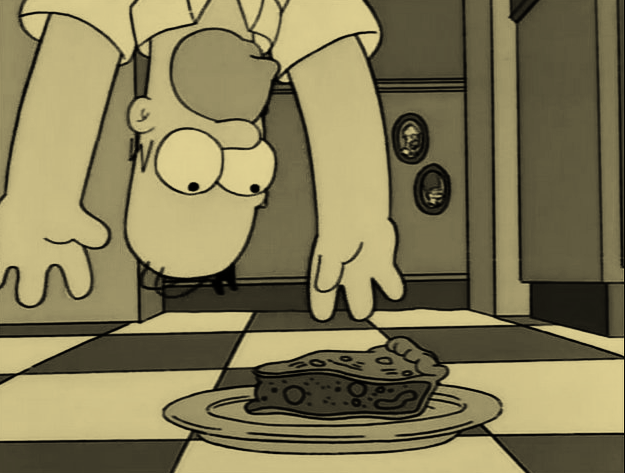
Two things pretty much led directly to the dominance of Sky in today’s television market. One is Premier League football, 104 years of tradition being tossed aside for a new money-led project that went on to dominate the sporting world, and Sky Sports will forever be irrevocably tied to it. The other key factor: a certain five-member family from Springfield.
Now the series seems utterly ubiquitous, where you can easily watch at least four full episodes a day without even thinking about firing up a streaming service (or blowing the dust off your DVD player), it seems unlikely now that watching The Simpsons ever felt to be the sole preserve of a lucky few. While the family had originally been introduced to British audiences in screenings of The Tracey Ullman Show on BBC2 (which aired 46 times between 1988 and 1991, if you’re wondering, though not all episodes featured Homer et al), their spin-off series was Sky-exclusive. And Sky knew how to make the most of it.

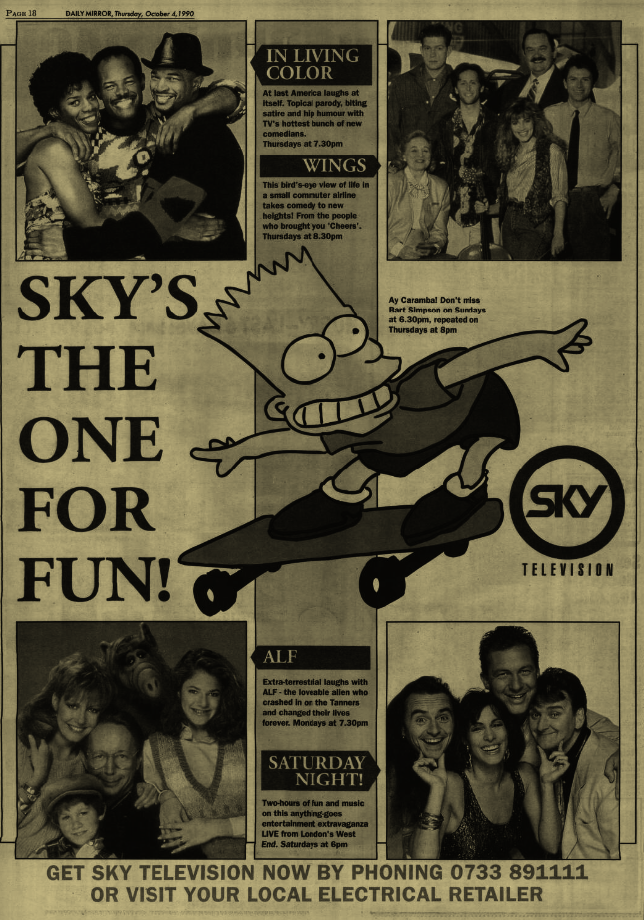
I mean, just look at that line-up. Alf had already been on ITV, In Living Color and Wings really weren’t going to convince anyone to bolt a binlid to their house, nor was a live two-hour Saturday night ‘entertainment extravaganza’ starring Matt Lorenzo, Neil “Heil Honey” McCaul, Jane Alexander and Mickey Hutton. No wonder all hopes for getting football refuseniks onto Sky were pinned on Bart Simpson (Homer being a much lesser beacon in those early years). And that was how it generally panned out. Unless you were willing to make do with buying three-episode VHS tapes of the series from John Menzies, or could convince a dish owner to record a few episodes for you, that was the only way you’d get to see The Simpsons during its Golden Age.
Then in November 1996, everything changed. The programme everyone wanted to see was no longer going to be the exclusive preserve of Pay TV. It was going to be on BBC1. This was big news. They were on the cover of the Radio Times (along with several other magazines, even including Loaded). Saturday nights, kicking off the evening’s entertainment at 5.30pm each week. It couldn’t fail.
And then they used the slot to show early episodes of the series (starting with There’s No Disgrace Like Home, S1E4), from before the show had become the breathless cavalcade of comedy it was known for, and many viewers instead opted for Sabrina the Teenage Witch on ITV instead. By the end of February 1997, The Simpsons had been retired from the pre-6pm slot on Saturday night BBC1, and repeats of Dad’s Army were swiftly parachuted in. Mind Godfrey’s hip.
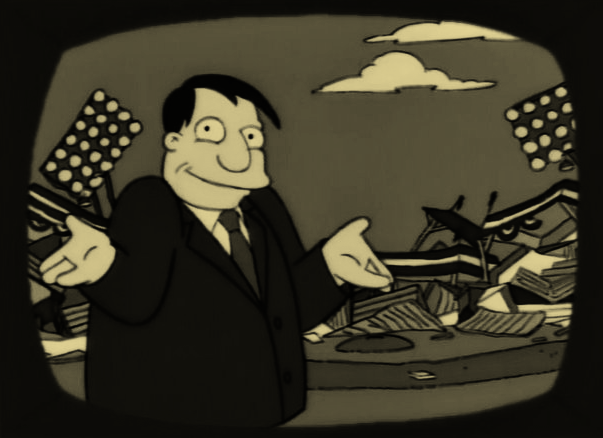
A piece in The Stage, dated 27 Feb 1997, covered the switch to Two:
SIMPSONS IN CHANNEL SWITCH
BBC Television has denied it is moving The Simpsons to BBC2 because of competition from ITV’s American import Sabrina, the Teenage Witch.
A Corporation spokesman claimed the cartoon as moved from its original Saturday timeslot because it came to the end of a 13 week run.
He said: “We always beat Sabrina in the ratings, but we came to the end of the run and were desperate for another slot. So we decided to capitalise on the show’s popularity by bringing it back twice a week on BBC2.”
However, ITV sources claim that although The Simpsons started off winning viewers from its rival, the tables soon turned and The Simpsons was beaten.
An ITV spokeswoman said: “Presumably the BBC found Sabrina too strong an opponent.”
The Stage, 27 February 1997
It seems the Beeb had expected The Simpsons to be facing a declining Baywatch, rather than an increasingly popular newcomer. And indeed, come Monday 10 March 1997, that was where they landed. The Simpsons would go out every Monday and Friday at 6pm, with The Fresh Prince of Bel-Air and Star Treks TNG and DS9 taking the slot on the other weekdays.
And that’s what really made the show a bona BBC hit (averaging a decent 3.4m viewers), and it would stay in that 6pm slot for the rest of it’s stay at the Beeb. Initially going out every Monday and Friday, but rapidly filling in where other weekdays were going spare, and appearing on the channel nine times in the week leading up to Christmas 1998.
From 25 February 2002, Simpsons episodes each weekday on BBC2 finally became a regular occurrence, perhaps not coincidentally that being the week it was reported Channel Four had snaffled up The Simpsons at a cost of £700,000 per episode. This at least meant the BBC would retain the rights until 2004, and they were determined to make the most of them.
And that’s no surprise – the show would make BBC2’s ratings top ten on 669 occasions between 1998 and 2004, reaching a high of 6.42m viewers on 7 Dec 1998 .
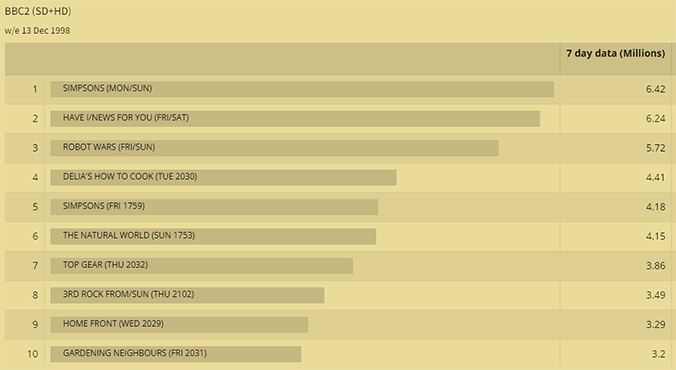
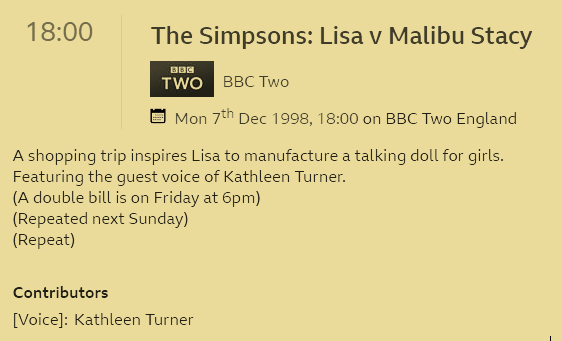
That most popular episode? Lisa vs Malibu Stacey. Why? Don’t ask me, I’m just a girl. Tee-hee-hee.

=87: Nai Zindagi – Naya Jeevan
(Shown 1010 times, 1968-1982)

One thing that’s really noticeable with the BBC of the past, is that they really did make an effort to offer something for everyone, even if it wasn’t always during peak viewing hours. Whether the target audience sought religious programming, to improve their French- or Italian-language skill-set, adult literacy assistance, signed programming for the hard of hearing, or all the hot and steamy farming news.
Much of this niche programming went out on Sunday morning BBC1, including the next entry in the rundown. Nai Zindagi – Naya Jeevan (‘New Life (in Urdu) – New Life (in Hindi)’, if you’re wondering) first featured in the Sunday morning schedule on 24 November 1968 . For the first time, there was programming on offer for Hindi- and Urdu-speaking viewers.

With just thirty minutes each week, and quite a lot to cover (you know, music, interviews, a round-up of news from an entire sub-continent), one can only imagine how difficult it must have been to prepare for each show, not least given that the BBC’s previous attempts at catering for a British-Asian audience hadn’t lasted too long.
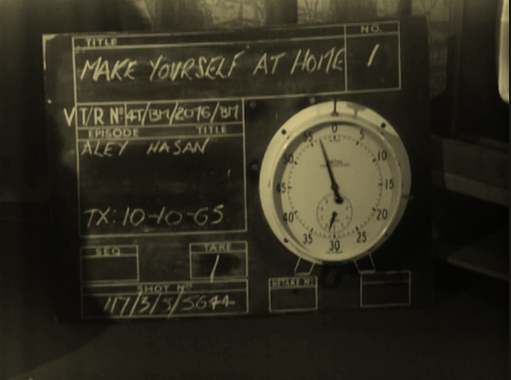
1965’s ‘In Logon Se Miliye’ ran for just thirteen episodes, airing at 9am on Sunday mornings with a midweek early-afternoon repeat. This followed the weekly BBC Home Service radio programme ‘Apna Hi Ghar Samajhiye’ (‘Make Yourself at Home’), which included news reports from Britain and overseas, combined with “Gramophone records and music from India and Pakistan”, which aired at around 8am each Sunday morning. Indeed, the two programmes were so in tune with each other, the Radio Times listings for In Logon Se Miliye requested that any correspondence to the TV series be addressed to the radio programme. With the two so intertwined, it made sense for In Logon Se Miliye to be renamed ‘Apna Hi Ghar Samajhiye’ in January 1966, so that both programmes shared a name as well as a production team.
The BBC’s official BBC100 pages contain a comprehensive write-up of Apna Hi Ghar Samajhiye by the University of Sussex’s Professor David Hendy, which also includes a variety of clips and interviews: https://www.bbc.com/historyofthebbc/100-voices/people-nation-empire/make-yourself-at-home/ – Well worth a look if you’re interested.
Nai Zindagi – Naya Jeevan wasn’t to be the sole offering aimed at a British-Asian audience during its time on air. 1977 saw the introduction of Gharbar, a companion programme catering for Asian women. Initially scheduled for a single 26-episode series, it would end up lasting until 1987. Indeed, Gharbar outlasted Nai Zindagi – Naya Jeevan, the latter being replaced in 1982 by a new, more news-based programme for Asian viewers, still broadcast in Urdu and Hindi. Asian Magazine first aired in April 1982, running until 1987, where (along with Gharbar) it would represent the BBC1’s final foray into Urdu- and Hindi-language programming.
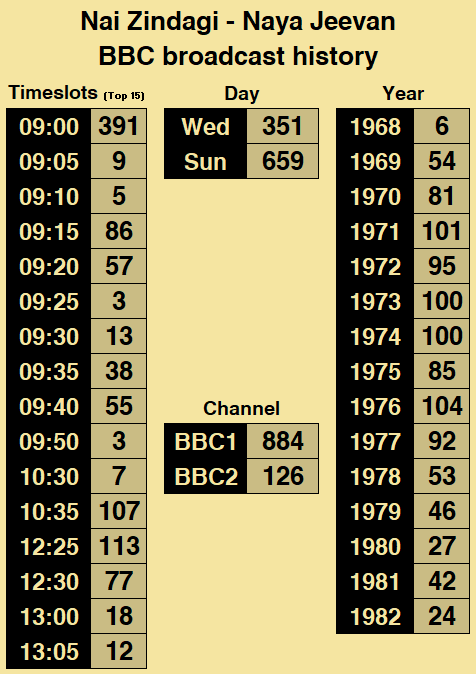
=87: QI
(Shown 1010 times, 2003-2021)
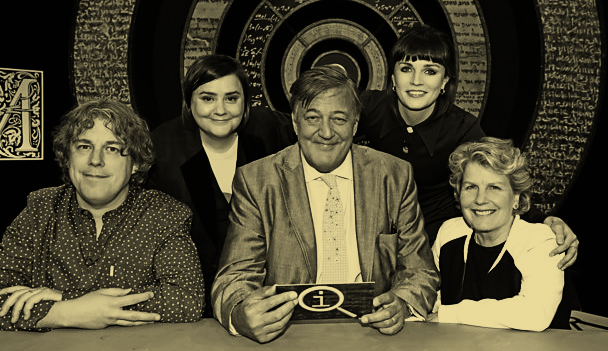
By 2003, it was established fact that no matter where you were in London, you were never more than six feet away from someone recording a comedy panel show. In the same way that both Wales and New Zealand famously contain more sheep than human beings, there were actually more panel-based wry sideways glances at things than scripted works on television and radio at the time.
Now, that’s not actually true, but it makes you think. After all, it was a time when ‘It’s Only TV…but I Like It’ got to four full series on primetime BBC One, despite only seventeen people remembering it nowadays.
It was in that media landscape that John Lloyd, the seemingly unstoppable producer of TV comedy legends like Not the Nine O’Clock News, Hitchhiker’s Guide to the Galaxy, Spitting Image and Blackadder, announced he’s devised a new panel show that everyone would just love.
I must admit, at the time I was more than a little sceptical. By this point, the average flying time of a new panel-based comedy show was akin to a newbie WWI pilot, yet here was John Lloyd of all people with another one. One bullish enough to claim it had been devised for a very specific run of 26 series (VIDIPRINTER: TWENTY-SIX). Involvement of Stephen Fry or not, it seemed unfathomable that it could have such staying power.
Yeah, you know the rest. It ended up proving a huge success. In fact, it’s been so successful, it’s now part of a very exclusive group of programmes to have aired on BBC One, BBC Two, BBC Three and BBC Four. The whole set. Admittedly, you’ll need to allow the QI segment of 2011’s Comic Relief special 24 Hour Panel People (highlights of which appeared on Three) to count, but still. Other than events like Eurovision or The African Nations’ Cup, very few actual programmes can claim to appearing on the full set of modern-day BBC channels, even with such an admittedly wobbly qualifier.
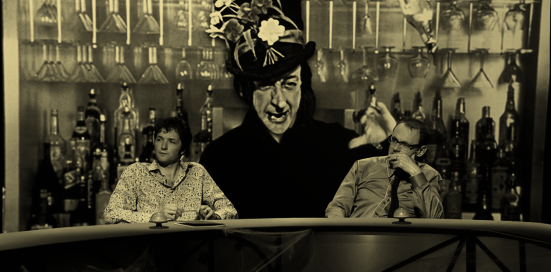
So, once it was on air, QI quickly became a favourite of people seeking something a little more cerebral from their desk-based comedy. No getting big laughs from hilariously pointing out that Eric Pickles was a bit on the portly side, or that Daleks can’t go up stairs. Indeed, at least in the early years, QI actively docked points from participants who’d trot out an obvious gag in response to questions – though I’d say it’s quite notable that they halted that particular practice after certain panellists repeatedly triggered the hack klaxon.
With early episodes debuting on BBC Four (mainly as a digital driver to draw an audience to the fledgling channel, each ep would arrive in a 10pm spot on BBC Two the following week), by January 2009 (Series F) it had proved popular enough to see a HIGNFY-style promotion to the big leagues – a 9pm Friday night slot on BBC One. It never quite felt quite at ease on the channel, and soon found itself being tried out in different places. November 2009’s Series G went out in a 9.30pm Thursday night slot, before switching to a surprising pre-watershed 8.30pm Friday home a few weeks later. That’s where it stayed until May 2011, before moving back to a more suitable home on BBC Two.
That certainly felt about right. While ‘Have I Got News For You’ seemed to readjust itself to a place on BBC One, it never felt quite right for QI. A bit like a Molly Ringwald character feeling pressured to plaster on make-up to fit in with the cool kids rather than just being true to herself.
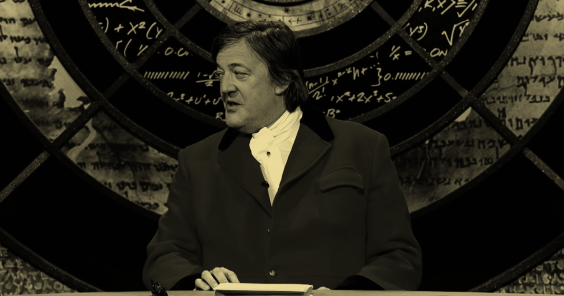
And so, from 2011 onwards, BBC Two has been the home of QI. Despite what some might see as a ‘relegation’ back to the second channel, it hasn’t hampered the programme one bit. Another format tweak also borrowed from HIGNFY – ‘enhanced’ same week repeats featuring a longer edit of each episode – would see QI XL (included in the figures here, as I’m counting repeats of everything else, it’s kind of the point) airing almost as regularly as the vanilla versions of QI. Even the 2015 announcement that host Stephen Fry was leaving the series didn’t dampen enthusiasm for the programme, with new host Sandi Toksvig proving a similarly capable foil for bouncy-haired troublemaker Alan Davies.
Sure, it doesn’t seem quite as essential as it once did – the sheer volume of episodes, most of which seem to be continuously pouring from a tap onto the Dave scheduled, can account for that – but it would be a fool’s errand to suggest QI won’t meet its original mission statement: clocking up a series for each letter of the alphabet before the QI elves are finally released back into the wild.

86: Laurel and Hardy
(Shown 1046 times, 1948-2005)

Okay, here’s a thing. For the most part, if a programme is called something, it’s that something. In the case of beloved comedy duo Laurel and Hardy, it’s either one of their original films, or an episode of the 1966-1967 Hanna-Barbera cartoon of the same name. And quite frankly, one of these things is less than the other.
But I’m going to combine the two anyway, and that’s for a number of reasons. 1) Going into each listing and accurately differentiating the two would be tricky and time-consuming, 2) Even if the cartoon spin-off couldn’t hold a candle to the originals, their popularity on Children’s BBC only confirms how beloved the duo were (and indeed, still are) across generations of young comedy fans, and 3) having Laurel and Hardy in this list is definitely preferable to having Wanted Down Under on there.
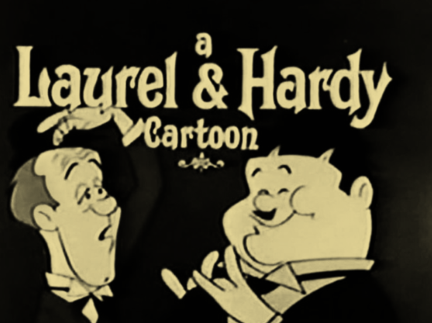
Aside from that, there were the expected difficulties in piecing together instances where (live-action) Stan and Ollie were actually broadcast. In many cases, they were billed as ‘Laurel and Hardy in’, which is fine and dandy. But in some instances, that wasn’t the case – it’s only in doing some last-minute fact checking that revealed (for example) nine screenings of A Chump at Oxford (ranging from 1950 to 2002) slipping through the net. And in many cases in the RT listings, there are indistinct billings that may well contain some Laurel and Hardy gold, or may not. Quite a lot of ‘Comedy Classics Double Bill’ or ‘Film Matinee’ in there, let alone the ominous total of one easily-identified L&H film being aired between 1936 and 1964.
Plus, on top of all that, there’s an argument for the Laurel & Hardy cartoon being more of a ‘proper’ programme than the films. After all, the Laurel and Hardy films are… films. I’m not going to include The Marx Brothers in this rundown (their work is more routinely listed as individual film titles, for one thing), so why should Laurel and Hardy warrant inclusion?
So, in short: I’m very much including Laurel and Hardy in here. As you will have noticed. And I’ve tried to pick up all the films of their that aren’t explicitly listed as being Laurel and Hardy films.
They generally only ever played the characters of Stan Laurel and Oliver Hardy in their films anyway, and I’m saying that’s enough to make their live-action antics a TV series that just happens to pre-date the medium of television. And the cartoon is just a continuation of that. Yeah, not an ideal situation, but to try and make up for it, I’ve done my best to put together broadcast histories for both live-action and animated Laurel and Hardy. Here you go! 309 animated episodes, 626 live-action. Try not to be too James Finlayson about it, eh?


If all that has put you in the mood for learning a little bit more about the pair German audiences knew as Dick and Dorf, I definitely recommend this 1974 episode of Omnibus. Intermingled with classic clips from their many films is rare archive footage and contributions from some truly A-List names – Jerry Lewis, Marcel Marceau, Spike Milligan, Bob Monkhouse, Dilys Powell, Hal Roach, Kenneth Tynan and Dick Van Dyke. Plus, on top of all that, it’s narrated by Eric Morecambe and Ernie Wise.
[UPDATE 3 AUG: With many thanks to Steve Arnold for bringing this to my attention, but the BBC showings of the L&H cartoons coincided with the L&H films being picked up by the ITV network. A quick peek at the superb TVRDB website confirms this, with at least 28 instances of Laurel and Hardy films appearing on Thames between 1982 and 1984, with at least three more on LWT during that same period.]

So, there we go. Another five entries ticked off the list, with just the last… Bloody hell, 85 to go.
Come back soon for the next segment of the series, where you’ll get to see how much research I managed to do on a programme that was last broadcast seventy years ago. And a particular programme that will be very familiar to everyone.



2 responses to “BBC100: The 100 Most-Broadcast BBC Programmes Of All Time (90-86)”
Just to let you know rugby special has been on the last few years as a 6 nations highlights show.
Am enjoying this website though.
LikeLike
[…] Strictly – It Takes Two(Shown 1006 times, 2004-2021)“Personally, I’m still surprised that Come Dancing (a) even […]
LikeLike